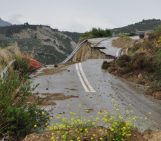
Often, in the news, we are used to seeing disaster statistics reported as isolated figures, placed into context by the tragic human cost of floods, earthquakes and drought. The recent Ecuadorian earthquake that occurred on Saturday the 16th April, for example, was described as having an estimated economic cost of $820 million, which could rise as the scale of the disaster is revealed. But beyond the shocking levels of destruction that these numbers can represent, can they teach us anything of humanity’s resilience to natural disasters?
Well, according to Dr James Daniell, a civil/structural engineer and geophysicist from the Karlsruhe Institute of Technology (KIT) in Germany, by combining the data for disasters reported between 1900 and 2015, interesting trends in vulnerability across the globe are revealed. Dr Daniell, who presented his results to the European Geoscience Union this week, along with colleagues from KIT and the General Sir John Monash Foundation, Australia, has discovered that up to $7 trillion worth of economic losses have occurred globally since 1900. This value was revealed by comparing economic costs for various natural disasters including floods, earthquakes, volcanoes, storms and drought using a collection of socio-economic indicators called the CATDAT Damaging Natural Disaster database.
Of this $7 trillion, the majority of financial costs have been from flooding disasters, which accounted for just over a third of losses. Since the 1960’s, however, this trend has started to shift, with storms and storm surges accounting for 30% of the losses. Storm and flooding damages have presented an interesting challenge for Dr Daniell and his team, as it can be difficult to separate the financial costs of these similar and often connected disasters. Luckily, the database has amassed over 30,000 sources in over 90 languages to attempt to clarify the various sources of economic loss.
As well as looking at trends over the last 115 years, by examining the relationships between disasters, socio-economic losses and vulnerability, Dr Daniell has come to a surprising realisation. Although the total number of deaths in disasters appears to be increasing, in comparison with the total global population the percentage of deaths is actually in decline, and so too is the associated economic cost for society.
“Here there is a clear trend, that many (but not all) countries are protecting themselves better against disasters by building better, and therefore and are reducing their risk of high losses.”
Dr Daniell also says that his data highlights the noticeably positive impact that flood prevention infrastructure, education and communication is having on resilience to flooding.
“Over the entire time period, half of people died due to flood. However, with better planning, warnings and preventive measures, the death rate due to floods is significantly decreasing.”
An additional benefit of this database is the rapid assessment of the potential economic consequences for future natural disasters it can provide, making it easier for communities and governments to plan for large scale natural disasters. It is clear the benefits of this study and the CATDAT database will continue to assist us into the future, in our attempts to manage the risks of our planet’s most destructive forces.
By Hazel Gibson, EGU General Assembly Press Assistant and Plymouth University PhD student.
Hazel is a science communicator and PhD student researching the public understanding of the geological subsurface at Plymouth University using a blend of cognitive psychology and geology, and is one of our Press Assistants this week.





sean
Great resource. The figures on the chart are really in depth analysis. Every year, there were people who got impact by natural disasters. The problems generally were created by the human itself. Lots of people died in the event of natural disasters. The environment needs to be kept naturally so disaster can be reduced. Earthquake threats can be minimized by creating a proper building code that withstands the earthquakes. Recently, people were not aware if their living place were exposed by the danger of its nature. That’s why their environments were damaged.